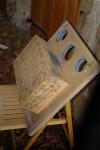
Originally Posted by
Zilch
From Vance Dickason Loudspeaker Design Cookbook, 7th Edition (current), P.10, Section 0.35 Dome Shapes:
"Concave dome radiators usually have much greater efficiency in the high frequency range, but a narrower directivity pattern. The higher efficiency is due in part to the wide peak caused by cavity resonances (although this can be damped to some extent) and the fact that convex domes are usually made of hard materials. Convex domes have a wider directivity pattern in the high frequency range, and lack the efficiency of concave domes in that range."




 Reply With Quote
Reply With Quote







